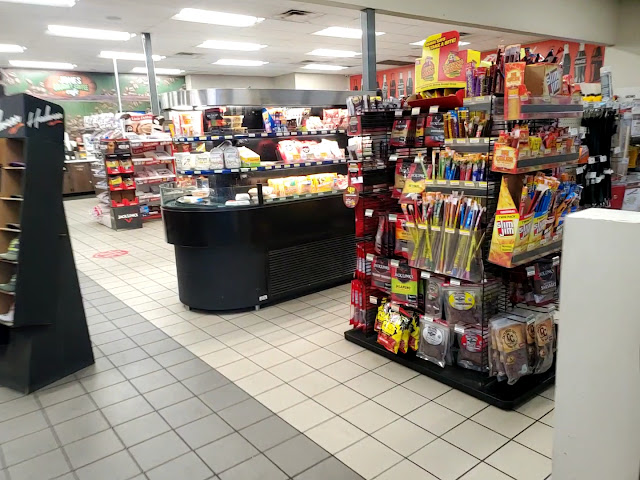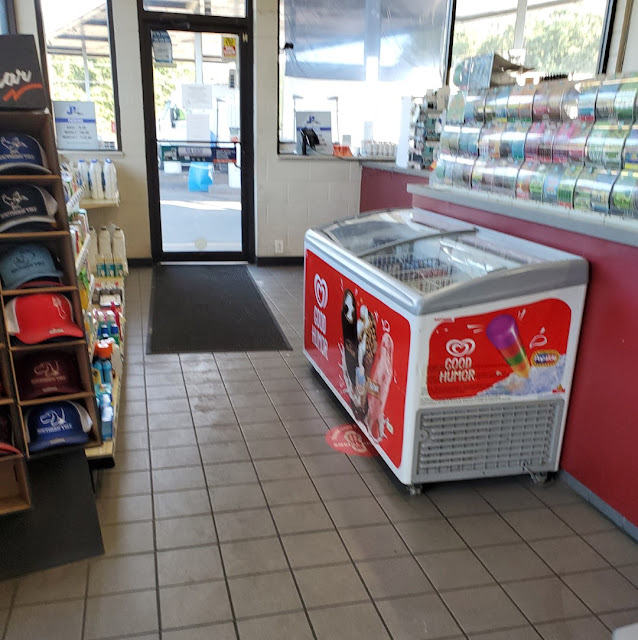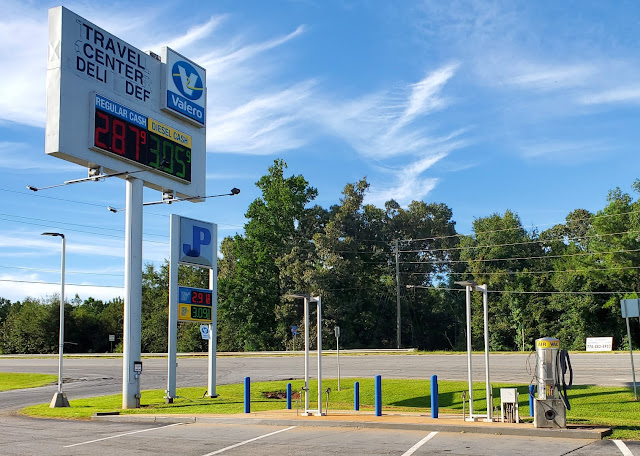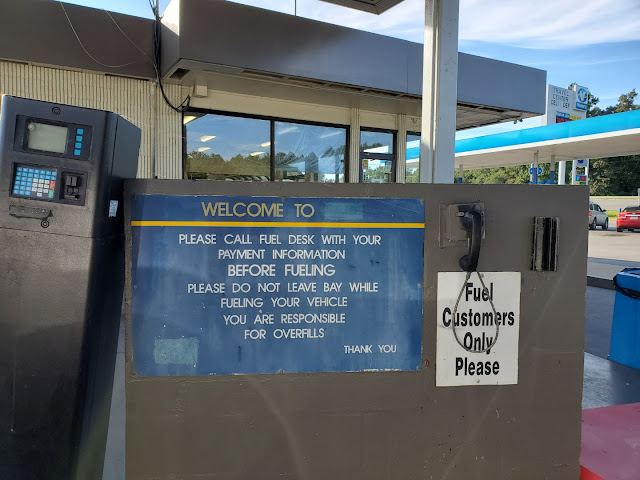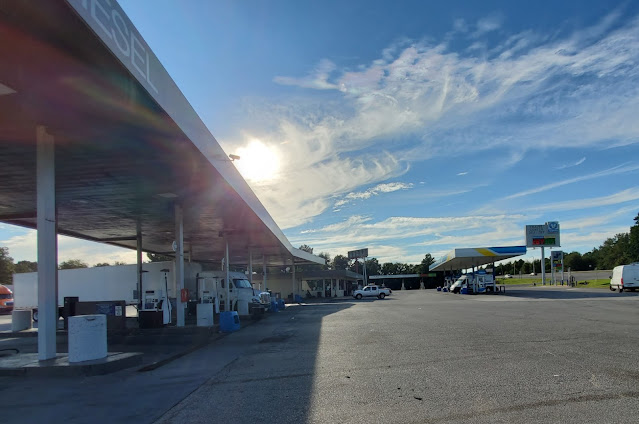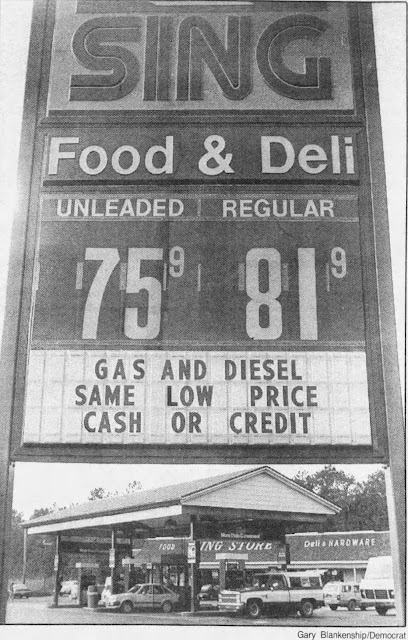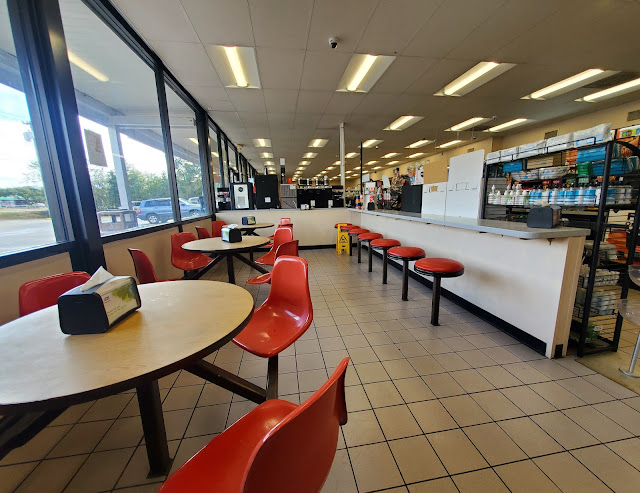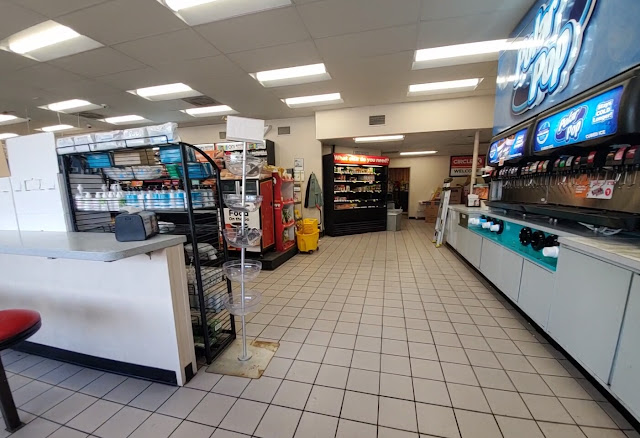Perry Travel Center - Perry, GA
Perry Travel Center
Sing Food Store | Deli | Truck Stop
517 Perry Parkway
Perry, GA 31069
While I don't know this for sure, I have heard rumors that one of the executives of Sing Oil Company was friends with Tom Love and that this station was modeled after a 1980's Love's truck stop. I typically don't believe anecdotal evidence like this, but after looking at several older Love's Travel Stops around Oklahoma City (where the company is based), I'm inclined to believe this. While they do have minor differences, the insides of these convenience stores have strikingly similar layouts, the fuel pumps are positioned similarly on the lot, and the Love's stores even feature a backlit awning design.
Regardless, this convenience store is the only one Sing ever built to look like this and is possibly the last station built by the pre-Amoco Sing Oil Co. (Jacksonville, FL #4 was also opened in 1989). I didn't expect much from my visit to this store, even though it is operated by the Georgia-based Jones Petroleum (and not Circle K). Needless to say, I was shocked by the end of my visit, but first let's crack open some historical newspapers.
Some History
For those who aren't familiar with the area, Exit 138 on I-75 was built in 1988 just to the north of the original alignment of Thompson Road. The new exit was expected to be a bastion of commercial development, with speculation of housing, restaurants, and lodging around the new Northrop plant. Opening around that time, the factory was intended to build the Triservice Standoff Attack Missile; two years after the DoD canceled the missile program in 1995, Northrop Grumman announced it would close this plant. Needless to say, Sing Oil Company was the only other business which decided to locate here compared to the much more popular Exit 136 / Sam Nunn Blvd. Even today, the only advertised businesses on the exit are this station and a Publix & McDonald's which are 2 miles east on Perry Parkway. This exit also caused confusion by originally being numbered 43A on Georgia's old sequential exit system. The modern Exit 136 was originally Exit 43, even though it is over a mile south. It seems like it is much easier for the DOT to add an exit now!
 |
| Courtesy The Houston Home Journal staff - The Houston Home Journal - May 27, 1989 |
The Houston Home Journal reported that this station would have its grand opening on June 5, 1989, and was a "new I-75 travel haven." Such amenities included four indoor pay phones, five truck fuel bays, and deli seating for 32. The photo above also shows Sing's late-1980's backlit awning and canopy design. I only know of one other station which received this prototype (Gulfport, MS), and I wonder how many other stations would have looked like this had Amoco not bought Sing.
I cannot say enough good things about the staff at The Houston Home Journal. I contacted them in an attempt to see if they still had the originals of these photos; while they did not, they were gracious enough to look through their physical paper archives and send me a better copy of the picture above.
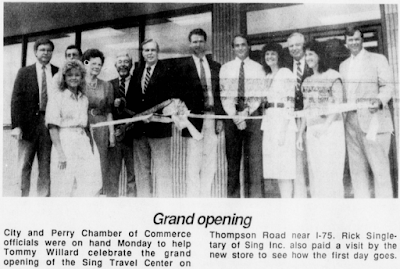 |
| Courtesy Georgia Historic Newspapers - The Houston Home Journal - June 21, 1989 |
The next article I found shows the grand opening of this station on June 19, 1989. It seems like the date was delayed a few weeks from the original plan; regardless, Tommy Willard, station manager, and Rick Singletary, grandson of Sing's founder L.H. Singletary, were present and pictured above with a host of others. This was a big moment for the company; not only was it the launch of a new concept, but it was possibly the last store to be opened. According to Tom Perry, Sing's former Executive VP & General Manager, Sing started to reserve resources as they began talks with Amoco about a potential merger. No stations were built or opened in the year leading up to the Amoco acquisition.
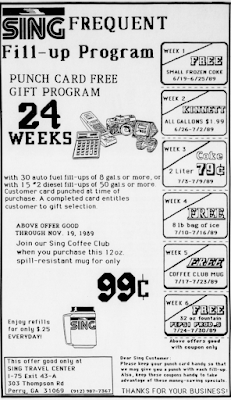 |
| Courtesy Georgia Historic Newspapers - The Houston Home Journal - May 31, 1989 |
Several ads were run for this station, with this one being the most '80s of them all. I love how they tried to look "high-tech" by using computer fonts and calling the sale a "punch card free gift program."
 |
| Courtesy Georgia Historic Newspapers - The Houston Home Journal - February 27, 1991 |
 |
| Courtesy Georgia Historic Newspapers - The Houston Home Journal - September 18, 1991 |
These next two ads are interesting because they show the window of time it took Amoco to rebrand the station. The Amoco-Sing merger was finalized on October 31, 1990, but it looks like Amoco exclusively used the Sing branding on the stations for about another year (shown by the first ad). By September, it seems like the company began to use the Amoco gas brand at Sing convenience stores before they sold off this station in 1994. As a reminder, Perry #1 was sold off in 1993.
The Store
From the front of the store, it looks like this building has not been modified much since it was constructed in 1989. Sing installed a similar greenhouse seating area on the front of the Gulfport store, and I believe this feature would have been more widely implemented had the company not been acquired.
One thing I was very excited to see upon walking into the store was this structure on the awning. If you zoom in, you can see fluorescent lights through the gaps which are part the original signage backlight! One day, I'll get around to sharing all of my pictures of the Gulfport station that also received a backlit awning and canopy. Meanwhile, I just was glad to see that there is a small chance this rare edition of Sing branding is still in-tact under the bland "food mart" signage. I would love to be at this station the day those panels get taken down! (You can see the structure in the first newspaper image I included above from 1989).
Stepping inside, we are greeted with the traditional convenience store fare and nothing that screams "Sing Oil Company" at me. I'd imagine that the floor tile could be original since this station is only 33 years old, in contrast to some like Columbus #8 with tile that is likely from the '70s.
Turning to the right, we see the seating area that has certainly been shrunk over the years. Last time I checked, six stools will not seat 32 people. I'd imagine there were originally some booths in this area that would have looked similar to this, with a row of four booths on either side of an aisle.
Here is the other side of the beef jerky shelf, looking back toward the doors and the cashier counter.
Moving straight ahead from the last picture, here is a look toward the door to the semi-truck fuel pumps. The door to the standard fuel pumps is to our left and the cashier counter and rest of the store to my right.
From there, we will back up a bit to take a look at the cashier counter. The door in the previous picture is the one right next to the cashier, and the main door to the regular gas pumps is in the left edge of the shot. I'd imagine that this station is still configured roughly the same as it was in 1989; moreover, several of the Love's truck stops I saw online use this same counter configuration. These cabinets are different than the ones I have seen in other former Sings but could have been a prototype that wasn't widely rolled out.
The store seems to have installed new cabinets in the coffee / fountain drink area which leads me to believe the rest of the store's fixtures have been replaced. I'm inclined to say the bulkhead which reads "Jones gourmet coffee cafe" dates back to Sing but I really cannot tell since this station was a one-off! The light fixtures have definitely been replaced in the last few years. It does, however, looks like this station has a few leaks in the ceiling that need to be repaired.
Here is a look at the drink area from a different angle, and we can see the hot food section that is attached to the cashier counter. I wouldn't be surprised if this store still has a full commercial kitchen behind the wall with the TVs, like Tallahassee #10. The hot food counter is home to a Subway in the Love's I have mentioned previously.
Here, we see an overview of the snack section of the store from the back left corner. For reference, the drink coolers are to my left and the café seating area is where the bulkhead sticks out in the center of the picture.
To wrap up the tour of the store, I took a picture from the same spot using my phone's wide-angle lens. My back is to the restroom hallway, and we can see the door is open to a storage room at the end of the cooler wall. I wish I knew how much of this store's interior was original, but I do feel confident that the layout has not changed.
Back Outside
Wow, to think that gas was $2.87 a gallon back in September; meanwhile, I passed a station today selling the same product for $4.09 a gallon. Is anybody else having flashbacks to 2008? It is amazing the influence that geopolitics have on the economy and how Russia invading Ukraine can cause gas prices in the US to skyrocket!
One of the most consistent remnants of a Sing is the pair of lights at the vacuum station; this store was no exception. I also wouldn't be surprised if the billboard sign was also original because Sing began to experiment with these larger signs in the late '80s at Gulfport and Tallahassee #7. Similar to this location, both of those stations are close to an interstate exit and probably wanted to get the attention of drivers who were passing through.
Another unique feature about this station when compared to other Sing Stores is the presence of these truck bays. I believe this canopy is original to the station's construction and strongly resembles this one from Love's.
Looking from one of the bays, we can see the truck entrance to the convenience store and more of the backlight structure on the awning.
That's odd, I wonder why it looks like somebody painted over a word on the sign that says "WELCOME TO"?
Let's take another look at that sign. It seems a bit old and faded to me.
Could it be?
A sign that still has the Sing logo on it! In the wild!! This is the kind of stuff I never dreamed I would find hanging around over 30 years after it was installed. If anybody ever needed proof that this travel center was run by Sing Oil Company, here it is! For the most part, the sign is still in its original condition except for the little bit of blue paint somebody used to cover up the Sing logo and "Sing" next to "Welcome To" at the top of the sign. Even better, this station has five of these signs, all in largely the same condition. I really want to get my hands on one of them before they make their way to the landfill. Maybe one day! I'd much rather worry about getting some 30-year-old blue paint off a logo than agonize over "the sign that got away."
The rest of the truck pumps aren't that interesting, and Sing's original Gilbarco Highlines have been replaced with some newer Wayne Ovation dispensers. I did read a few reviews stating these pumps still don't take credit or fleet cards, which is surprising for the 2020's.
We'll take one last look over the property before we head south on I-75. Unfortunately, between here and my next stop I had a rock fly up and crack my windshield. I still feel like this trip was worth it.
 |
| Courtesy Houston County Property Appraiser - Perry Texaco Travel Center |
Street Views
Aerial Views
 |
| Historic Aerials - 1981 Future site of the Perry Travel Center, with the old alignment of Thompson Road |
 |
| Google Earth - January 1993 Three-year-old Amoco-Sing Travel Center |
 |
| Google Earth - November 2019 The current station, with the old alignment of Thompson Road in the bottom of the picture |




